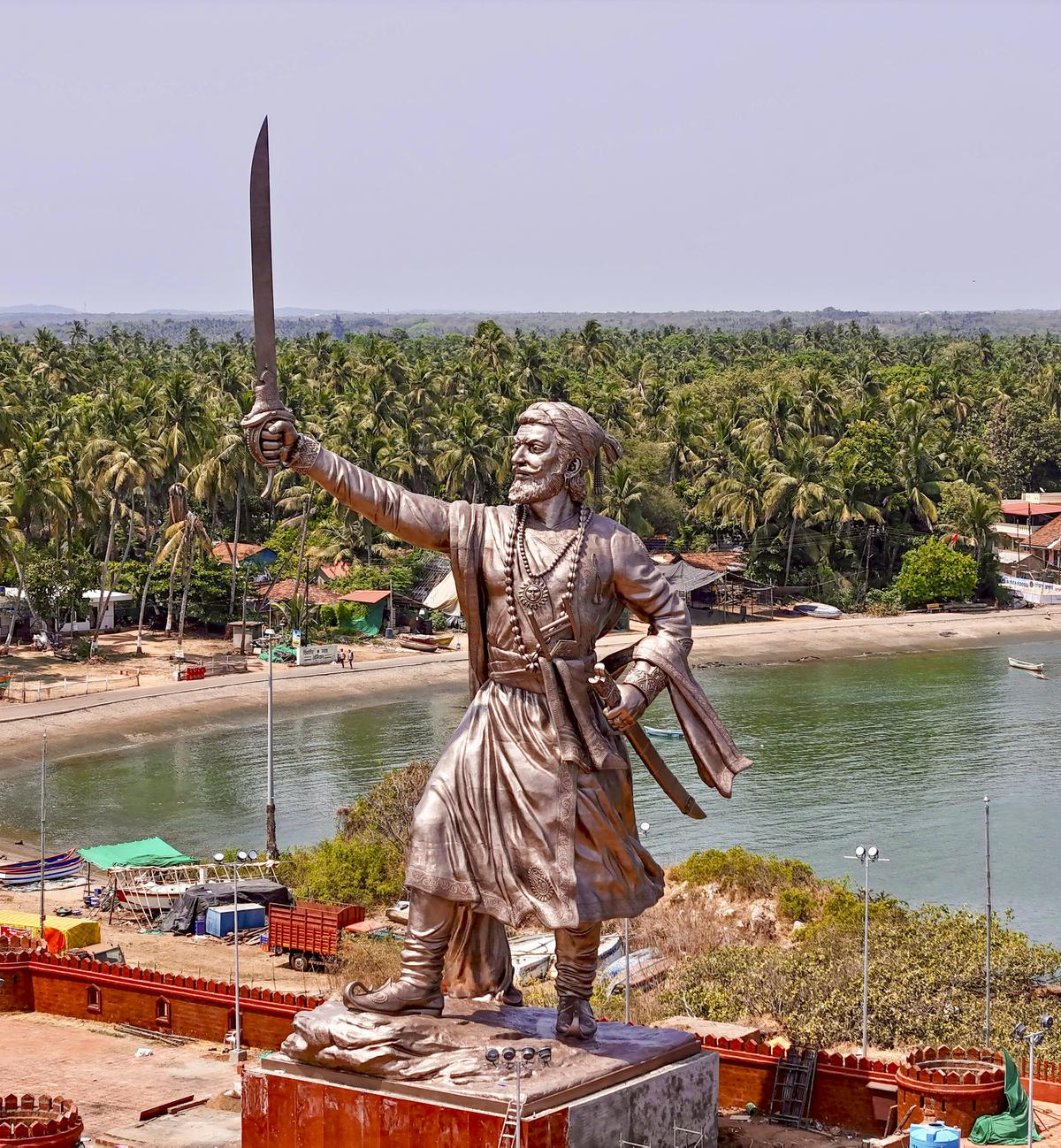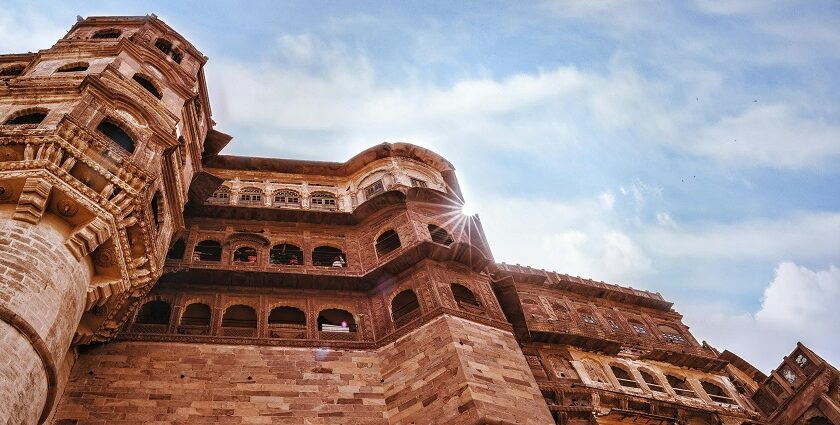Maharashtra Switch to Hindi
Statue of Shivaji Maharaj at Sindhudurg
Why in News?
On 11 May 2025, Maharashtra Chief Minister Devendra Fadnavis unveiled a statue of Chhatrapati Shivaji Maharaj at the Rajkot Fort in Sindhudurg.
Key Points
- About the Statue:
- The statue stands 91 feet tall, including a 10-foot pedestrian base, making it the tallest statue of Chhatrapati Shivaji Maharaj in India.
- According to the Chief Minister, the grand statue will inspire future generations and boost tourism by spurring development in the Sindhudurg region.
- The Maharashtra Public Works Department constructed the statue at a cost of Rs 31.75 crore.
- Renowned sculptor Ram Sutar’s company executed the project.
- Engineers used stainless steel framework, M50 grade concrete, and stainless steel bars to build the structure.
- The Indian Institute of Technology (IIT) Mumbai verified the statue’s concept and design for structural safety and durability.
- About Chhatrapati Shivaji Maharaj:
- Born on 19th February 1630, at Shivneri Fort, Pune was a visionary leader from the Bhonsle clan and the founder of the Maratha Empire, known for resisting the Mughal Empire and striving for self-rule.
- Major Battles: Battle of Pratapgad, Battle of Pavan Khind, Sacking of Surat, Battle of Purandar, Battle of Sinhagad, and Battle of Sangamner.
- The Wagh nakh, was used by Shivaji to kill Afzal Khan in the 1659 Battle of Pratapgad.
- Titles: Chhatrapati, Shakakarta, Kshatriya Kulavantas, and Haindava Dharmodhhaarak.
- Administration: Centralized administration with the Ashtapradhan (Council of Eight Ministers), abolished the Jagirdari System, implemented the Ryotwari System, and built a strong naval force for coastal defense.
- Major Battles: Battle of Pratapgad, Battle of Pavan Khind, Sacking of Surat, Battle of Purandar, Battle of Sinhagad, and Battle of Sangamner.
- Shivaji is renowned for his innovative guerrilla warfare tactics, which influenced subsequent rulers and shaped the Maratha Military Landscapes.
- Born on 19th February 1630, at Shivneri Fort, Pune was a visionary leader from the Bhonsle clan and the founder of the Maratha Empire, known for resisting the Mughal Empire and striving for self-rule.
Rajkot Fort
- Chhatrapati Shivaji Maharaj constructed Rajkot Fort between 1664 and 1667 in Malvan, Maharashtra, as part of his coastal defence strategy.
- The fort functioned as a vital military outpost for protecting coastal trade routes and was integrated into the broader Sindhudurg Fort complex.
- Positioned near the Arabian Sea, the fort's robust walls and strategic coastal location reflect the region’s rich maritime heritage and naval foresight under Shivaji’s rule.
- In 1766, the British entered into a treaty with the Chhatrapati of Karveer (a branch of the Maratha royal family).
- As part of this engagement, the British sought permission to establish a shipbuilding yard at Rajkot, highlighting the fort's continued strategic value even in the colonial era.
Maharashtra Switch to Hindi
Illinois Tech University New Campus in India
Why in News?
Illinois Tech University announced that India’s University Grants Commission (UGC) had formally approved its plan to open a new campus in Mumbai, making it the first American university to receive authorisation to establish a degree-granting campus in India.
Key Points
- About Mumbai Campus:
- Illinois Tech University will welcome students to its new Mumbai campus starting in Fall 2026.
- The campus will offer undergraduate and graduate degrees in high-demand fields such as Computer Science, Engineering, and Business.
- It will deliver the same experiential and industry-aligned curriculum as Illinois Tech’s Chicago campus.
- It will also include the university’s signature Elevate program, which guarantees students access to hands-on research, internships, and career-enhancing opportunities.
University Grants Commission (UGC)
- About:
- India's first effort to establish a national education system began with the 1944 Sargeant Report, which recommended creating a University Grants Committee.
- Formed in 1945, the committee initially supervised Aligarh, Banaras, and Delhi universities. By 1947, its scope expanded to include all existing universities.
- In 1948, the University Education Commission, led by Dr. S. Radhakrishnan, recommended its restructuring based on the UK model.
- In 1952, the Union Government designated the University Grants Commission (UGC) to oversee grants for Central Universities and higher education institutions.
- Formally inaugurated by Maulana Abul Kalam Azad in 1953 , it became a statutory body in 1956. The head office of the UGC is located in New Delhi.
- India's first effort to establish a national education system began with the 1944 Sargeant Report, which recommended creating a University Grants Committee.
- Composition:
- UGC is made up of a Chairman, a Vice-Chairman, and 10 other members. The Central Government appoints all members of the UGC.
- Key Functions:
- Assess universities' financial needs, and allocate and disburse grants for maintenance, development, and other purposes.
- Recommends improvements in higher education and assists in implementation.
- Assess universities' financial needs, and allocate and disburse grants for maintenance, development, and other purposes.










%20MPPCS%202025%20Desktop%20E.jpg)
%20MPPCS%202025%20Mobile%20E%20(1).jpg)



.jpg)






.png)
.png)



 PCS Parikshan
PCS Parikshan



